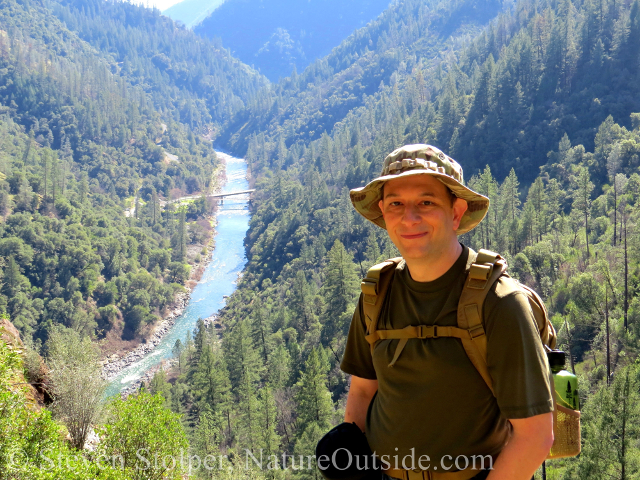
Each time you head out on the trail, you never know what awaits. Sometimes you see amazing wildlife. Another time you stumble onto a mountain lion cache. If you invest time in nature, she always rewards you with memorable experiences.
My Lucky Day
This day was special because I was able to trail a mountain lion. Usually when you see prints on a good substrate (i.e. a dusty trail), they go for 20 feet and then the animal veers off into the bush. It’s irritating!
Animal tracks abound in the forest. They’re all around us. But it’s easy to miss them entirely. Stone, hard ground, fallen leaves and pine needles conspire to keep the forest’s secrets. It’s the artful tracker who recognizes the subtle signs of an animal’s passage. He rises to the challenge and focuses like a brain surgeon. Then, detail by detail, he coaxes Mother Nature into gossiping about the neighbors.
But not me. I just get frustrated.
But on this day the mountain lion had somewhere to go. It used the trail for almost half a mile. I had a unique opportunity to trail the animal. Using the well-defined tracks, I could search for the ones that were difficult to find. I knew where they must lie from the animal’s gait. And whenever the tracks appeared to end, I could cast ahead for sign that allowed me to pick up the trail. It was thrilling to follow the cougar for so long.
Mountain Lion Track
Here’s a picture of one of the better mountain lion tracks. I label the pad and the toes to make the track easier to read. I provide tips for how to read a mountain lion track in another article.
Notice the mountain bike tracks that came after the lion. I doubt the cyclists had any idea the cat was nearby.
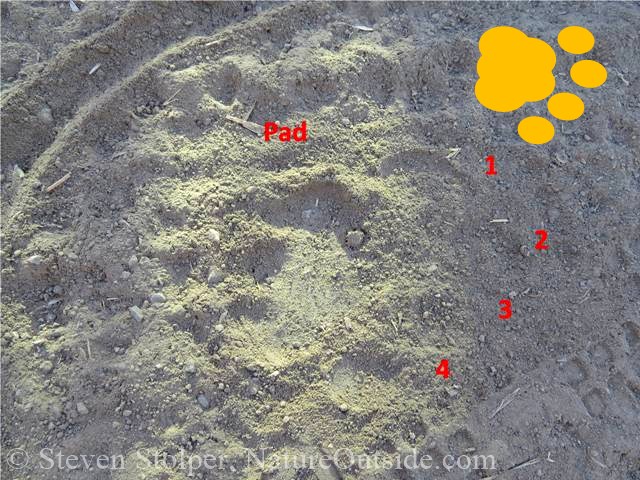
The cougar is moving from left to right
The pad is on the left and characterized by a three-lobed shape. It makes me conjure a mental image of the letters “E” or “M”. There are impressions from the four toe pads, with the second from the top the furthest in front. This is a smaller animal and we are looking at a front right track. What do you think and why? (answer).
Other Tracks
Conditions were ideal for tracking. So, let’s take a look at three more tracks. Two are from animals common throughout the United States. You probably see them all the time. Hopefully, taking 10 seconds to glance at these pictures will trigger an “Aha!” moment the next time you come across their tracks in the bush.
The third track is an animal familiar to Californians. Don’t forget that you can track almost any creature, not just mammals.
Brush Rabbit
This animal commonly “gallops” with its rear legs landing ahead of its fronts. The animal in this picture is moving right to left. The round shape of the tracks and their distinctive “triangle” pattern are easy to identify. Can you visualize how the rabbit moves to create this pattern?
See if you can use your arms and legs to move like the rabbit that made these tracks.
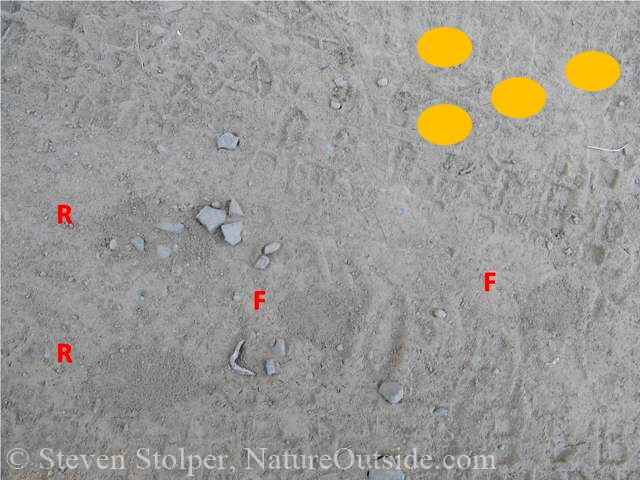
The rabbit is moving from right to left. The rear feet land ahead of the front ones.
Striped Skunk
This animal is also moving right to left in the picture. The rear foot is ahead of the front. The front is distinguished by a much larger distance between the toe prints and the claw marks of the middle toes. The skunk has larger front claws to help forage for food.
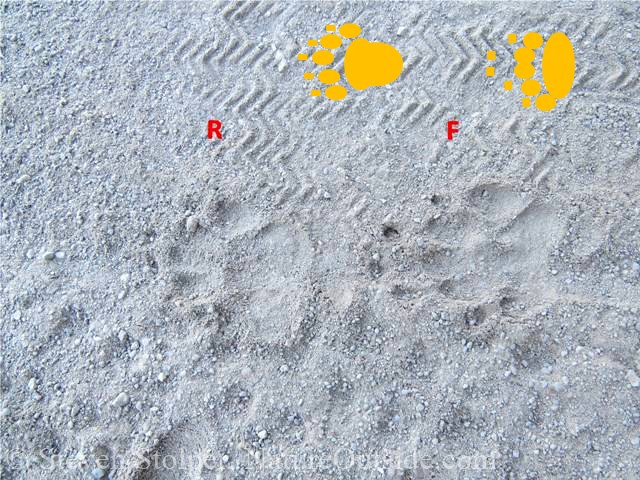
The skunk is moving from right to left. The hind foot lands ahead of the front.
California Quail
This last track makes me smile. California Quail are gorgeous birds that run along the ground more than they fly.
The small toe that faces backward is called the hallux. It points to the center of the bird. So this is a right track.
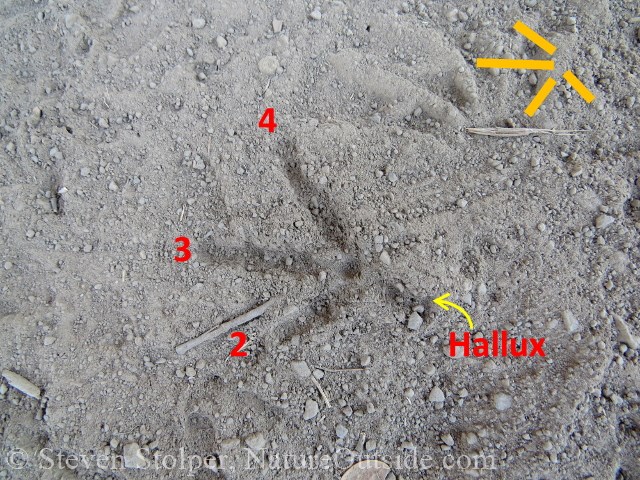
You can track birds, reptiles, insects, and amphibians as well as mammals.
Get out there and Track
You don’t need to be an expert to track animals. You just need your senses and your brain. Challenge yourself to look for animal tracks next time you are out hiking. And once you learn to find tracks, start imagining how the animal moved to create them. It’s as if the animal dances before you!
Please feel free to use the comments below to share your tips and tricks to identify these animals’ tracks.
Further Reading
These are affiliate links.
Mammal Tracks & Sign: A Guide to North American Species by Mark Elbroch
Tracker’s Field Guide: A Comprehensive Manual For Animal Tracking by James Lowery
Related Articles on NatureOutside
Mountain Lion Tracks – Learn to Read Them
Mysteries on the Beach (Part 1)
Stalking the Black Bear – High Adventure in the Forest (Part 1)
For fun facts and useful tips, join the free Bushcraft Newsletter.



Hi Steve. Thanks for you great website! I just got an 80% on your identifying mountain lion tracks test. By the way, I live in the same community – Pinon Pines – as James Lowery. We are surrounded by the Los Padres Nation Forest, a great area for learning about wildlife. Anyway, I bought his book about 10 years ago; I have learned so much from it. I just met Jim for the first time a couple of weeks ago. I showed him a picture I had taken of what I was sure was a mountain lion track. To my great joy, Jim and he confirmed it was indeed a mountain lion! I felt so proud. Anyway I just thought you might enjoy reading this. thanks again. (P.S. In the 14 years I have lived here I have only seen a lion once, from a distance, maybe 300 yards. I could not be sure it was a lion, but it was the color of a lion and when it spotted me it ran up the side of a hill. It did not hop like our resident deer so I assume it was a cat).
Frank Manning, Pinon Pines, Kern County California
Frank, I really enjoyed your comment. Jim is a terrific tracker and a wonderful teacher. And you were so fortunate to see a lion in the wild! Enjoy your beautiful surroundings, the Los Padres National Forest is an amazing place.